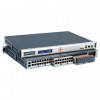Lantronix SLC 8000 Advanced Console Manager User Guide - Page 68
Logging Out, Command Syntax, Command Line Help, Tips, Web and Command Line Interfaces
 |
View all Lantronix SLC 8000 Advanced Console Manager manuals
Add to My Manuals
Save this manual to your list of manuals |
Page 68 highlights
5: Web and Command Line Interfaces Logging Out To log out of the SLC command line interface, type logout and press Enter. Command Syntax Commands have the following format: where is set, show, connect, admin, diag, or logout. is a group of related parameters whose settings you want to configure or view. Examples are ntp, deviceport, and network. is one or more name-value pairs in one of the following formats: User must specify one of the values (aa or bb) separated by a vertical line ( | ). The values are in all lowercase and must be entered exactly as shown. Bold indicates a default value. User must specify an appropriate value, for example, an IP address. The parameter values are in mixed case. Square brackets [ ] indicate optional parameters. Command Line Help For general Help and to display the commands to which you have rights, type: help For general command line Help, type: help command line For release notes for the current firmware release, type: help release For more information about a specific command, type help followed by the command. For example: help set network or help admin firmware Tips Type enough characters to identify the action, category, or parameter name uniquely. For parameter values, type the entire value. For example, you can shorten: set network port 1 state static ipaddr 122.3.10.1 mask 255.255.0.0 to se net po 1 st static ip 122.3.10.1 ma 255.255.0.0 Use the Tab key to automatically complete action, category, or parameter names. Type a partial name and press Tab either to complete the name if only one is possible, or to display the possible names if more than one is possible. Following a space after the preceding name, Tab displays all possible names. Should you make a mistake while typing, backspace by pressing the Backspace key and/or the Delete key, depending on how you accessed the interface. Both keys work if you use VT100 emulation in your terminal access program when connecting to the console port. Use the left and right arrow keys to move within a command. Use the up and down arrows to scroll through previously entered commands. If desired, select one and edit it. You can scroll through up to 100 previous commands entered in the session. SLC™ 8000 Advanced Console Manager User Guide 68















